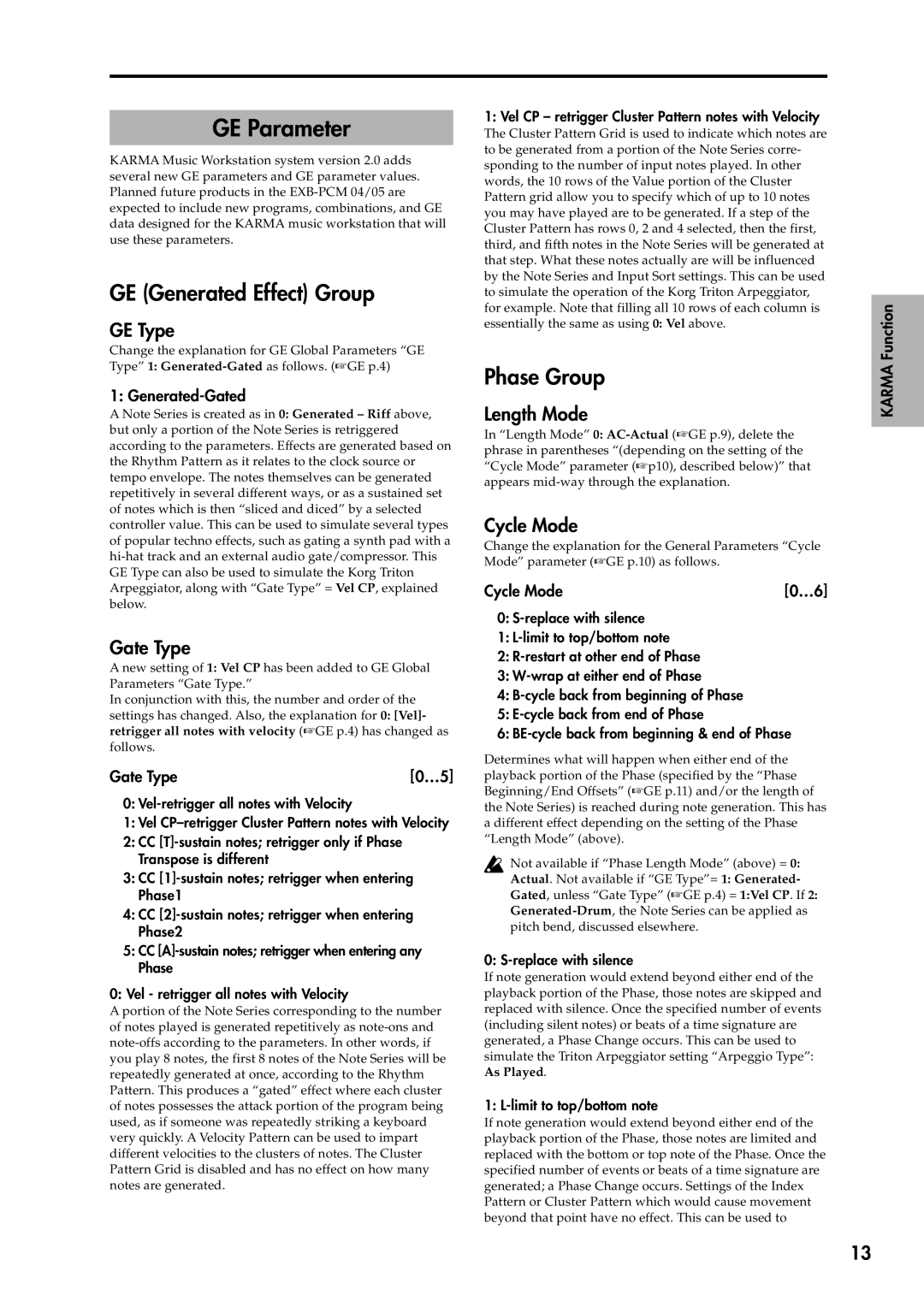
GE Parameter
KARMA Music Workstation system version 2.0 adds several new GE parameters and GE parameter values. Planned future products in the
GE (Generated Effect) Group
GE Type
Change the explanation for GE Global Parameters “GE Type” 1:
1:
A Note Series is created as in 0: Generated – Riff above, but only a portion of the Note Series is retriggered according to the parameters. Effects are generated based on the Rhythm Pattern as it relates to the clock source or tempo envelope. The notes themselves can be generated repetitively in several different ways, or as a sustained set of notes which is then “sliced and diced” by a selected controller value. This can be used to simulate several types of popular techno effects, such as gating a synth pad with a
Gate Type
A new setting of 1: Vel CP has been added to GE Global Parameters “Gate Type.”
In conjunction with this, the number and order of the settings has changed. Also, the explanation for 0: [Vel]- retrigger all notes with velocity (☞GE p.4) has changed as follows.
Gate Type | [0…5] |
0:
1:Vel
2:CC
3:CC
4:CC
5:CC
0:Vel - retrigger all notes with Velocity
A portion of the Note Series corresponding to the number of notes played is generated repetitively as
1:Vel CP – retrigger Cluster Pattern notes with Velocity
The Cluster Pattern Grid is used to indicate which notes are to be generated from a portion of the Note Series corre- sponding to the number of input notes played. In other words, the 10 rows of the Value portion of the Cluster Pattern grid allow you to specify which of up to 10 notes you may have played are to be generated. If a step of the Cluster Pattern has rows 0, 2 and 4 selected, then the first, third, and fifth notes in the Note Series will be generated at that step. What these notes actually are will be influenced by the Note Series and Input Sort settings. This can be used to simulate the operation of the Korg Triton Arpeggiator, for example. Note that filling all 10 rows of each column is essentially the same as using 0: Vel above.
Phase Group
Length Mode
In “Length Mode” 0:
Cycle Mode
Change the explanation for the General Parameters “Cycle Mode” parameter (☞GE p.10) as follows.
Cycle Mode | [0…6] |
0:
1:
2:
3:
4:
5:
6:
Determines what will happen when either end of the playback portion of the Phase (specified by the “Phase Beginning/End Offsets” (☞GE p.11) and/or the length of the Note Series) is reached during note generation. This has a different effect depending on the setting of the Phase “Length Mode” (above).
Not available if “Phase Length Mode” (above) = 0: Actual. Not available if “GE Type”= 1: Generated- Gated, unless “Gate Type” (☞GE p.4) = 1:Vel CP. If 2:
0: S-replace with silence
If note generation would extend beyond either end of the playback portion of the Phase, those notes are skipped and replaced with silence. Once the specified number of events (including silent notes) or beats of a time signature are generated, a Phase Change occurs. This can be used to simulate the Triton Arpeggiator setting “Arpeggio Type”: As Played.
1:
If note generation would extend beyond either end of the playback portion of the Phase, those notes are limited and replaced with the bottom or top note of the Phase. Once the specified number of events or beats of a time signature are generated; a Phase Change occurs. Settings of the Index Pattern or Cluster Pattern which would cause movement beyond that point have no effect. This can be used to
KARMA Function
13
